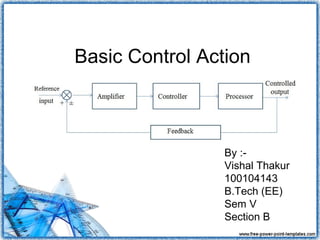
Control actions
- 1. Basic Control Action By :- Vishal Thakur 100104143 B.Tech (EE) Sem V Section B
- 2. Introduction • A controller compares the actual value of output with the reference input, determines the deviation, and produces a control signal that will reduce the deviation to zero or to a small value. • The manner in which the controller produces the control signal is called the control action.
- 3. Block Diagram of a Basic Industrial Control System
- 4. Classifications of Controllers. • 1. Proportional controllers • 2. Integral controllers • 3. Proportional-plus-integral controllers • 4. Derivative controllers • 5. Proportional-plus-derivative controllers • 6. Proportional-plus-integral-plus- derivative controllers
- 5. Proportional Control of Systems.
- 6. • Actuating signal is proportional to error signal • Such a system always has a steady-state error in the step response. Such a steady- state error is called an offset.
- 7. Change in gain in P controller • Increase in gain: → Upgrade both steady-state and transient responses →Increases oscillations → Reduce steady-state error → Reduce stability!
- 8. Integral Control of Systems.
- 9. Integral Controller • Integral of error with a constant gain → increase the system type by 1 →eliminate steady-state error for a unit step input → amplify overshoot and oscillations
- 10. Proportional-Plus-Integral Control • To eliminate offset, the proportional controller may be replaced by a proportional-plus-integral controller. • If integral control action is added to the controller, then, as long as there is an error signal, a signal is developed by the controller to reduce this error, provided the control system is a stable one.
- 11. Change in gain for PI controller • Increase in gain: → Do not upgrade steady-state responses → Increase slightly settling time → Reduces stability and bandwidth of system → Increase oscillations and overshoot!
- 12. Derivative Controller • Differentiation of error with a constant gain → detect rapid change in output → reduce overshoot and oscillation → do not affect the steady-state response
- 13. Proportional-Plus-Derivative Control With derivative action, the controller output is proportional to the rate of change of the measurement or error.
- 14. Effect of change for gain PD controller • Increase in gain: → Upgrade transient response → Decrease the peak and rise time → Improves stability and bandwidth of system → Increase overshoot and settling time!
- 15. Proportional-Plus-Derivative -Plus-Integral Control • A proportional–integral–derivative controller (PID controller) is a control loop feedback mechanism widely used in industrial control systems – a PID is the most commonly used feedback controller. • A PID controller calculates an "error" value as the difference between a measured process variable and a desired setpoint. The controller attempts to minimize the error by adjusting the process control inputs.
- 16. • The PID controller calculation involves three separate constant parameters, and is accordingly sometimes called three-term control: the proportional, the integral and derivative values, denoted P, I, and D. • These values can be interpreted in terms of time: P depends on the present error, I on the accumulation of past errors, and D is a prediction of future errors, based on current rate of change.
- 17. Changes in gains for PID Controller
